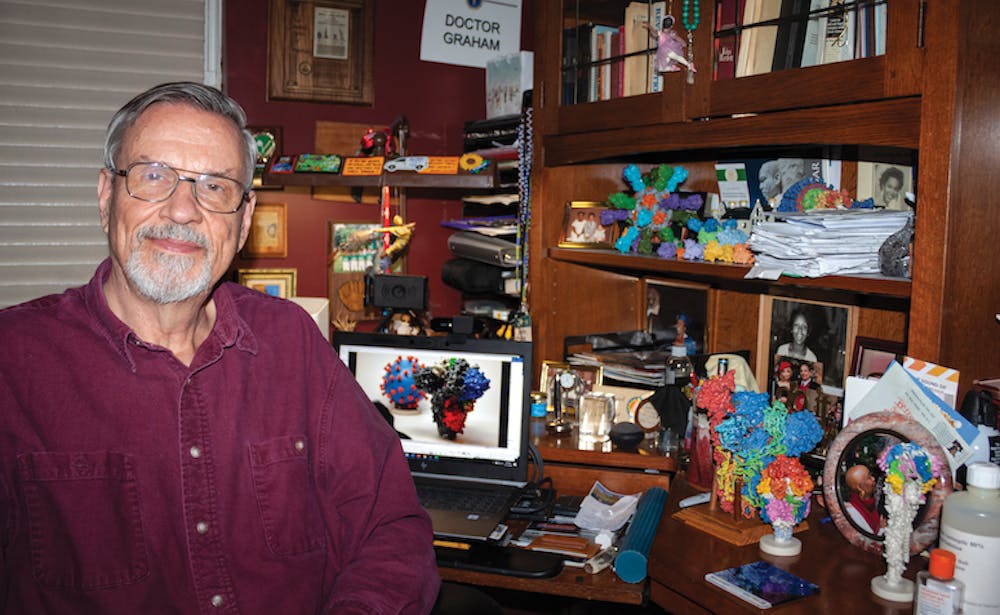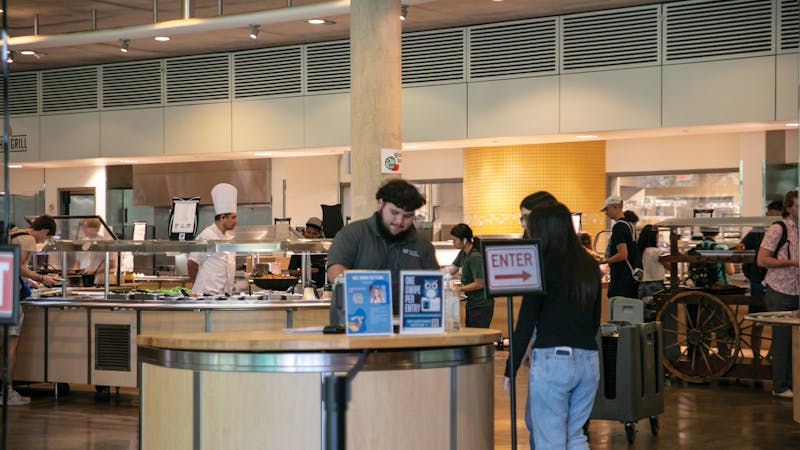Rice alumnus named a TIME 2021 Hero of the Year

Rice alumnus Barney Graham ’75, a renowned virologist whose research led to the development of the Moderna COVID-19 vaccine, has been named a 2021 Hero of the Year by TIME Magazine.
TIME Magazine extended its “Person of the Year” category in 2021 to include “Hero of the Year,” awarding the title to Graham and three other prominent vaccine scientists who developed the COVID-19 vaccine — Kizzmekia Corbett, Katalin Kariko and Drew Weissman.
“The miracle workers behind the COVID-19 vaccines are the TIME Heroes of the Year not only because they gave the world a defense against a pathogen, but also because the manner of that astonishing achievement guards more than our health: They channeled their ambitions to the common good, talked to one another and trusted in facts,” TIME Magazine wrote.
Graham, a Will Rice College alumnus, said that it was a shock when he learned that he had been named a TIME’s Hero of the Year.
“I knew I had done the interview, and I had some pictures taken, but I didn’t know what they were going to do with that information,” Graham said.
Graham said that he and his fellow TIME’s heroes of the year are representative of all the scientists that have been so involved in the vaccine development process.
“It has literally taken thousands and thousands of people to get this done, and not to mention volunteers,” Graham said. “And at the same time, you have all these health care professionals seeing patients in emergency rooms and hospitals trying to just survive. And so it’s a little hard to be called the hero when so many people have been doing so much difficult work over this time. But if you think of it as a representation or how science has impacted this process, then we can deal with it.”
According to Graham, the development of the COVID-19 vaccine was a result of many threads of scientific research coming together to make it happen.
“One of those threads was all the work on HIV and HIV vaccines over the last 40 years,” Graham said. “We still don’t have an HIV vaccine, we may never have one. But the work involved in trying to understand the biology well enough to make an HIV vaccine, that’s what’s led to these technologies that have made things like the RSV vaccine, and now Coronavirus vaccine usable.”
Graham said he had the privilege of being at the center of the Vaccine Research Center, which he founded in around 2000.
“That’s when several of us went there to start this new concept and bring multidisciplinary groups together in one place to try to work on an HIV vaccine,” Graham said. “Being in that environment and having those resources and all the different disciplines around me is part of what I was able to exploit to make the successful vaccines virus being Ebola and coronavirus.”
Graham said that he wants to highlight that the successful development of the COVID-19 vaccine is a real testament to basic research.
“[It’s] this idea that doing basic research to understand things in more depth and to understand how biology works in more detail will lead to breakthroughs at some other point,” Graham said. “Things that may not seem practical or relevant at the time could be very important later.”
Graham said that the VRC had a program already set up with Moderna on pandemic preparedness because of their experience with them during the 2016 Zika pandemic response.
“And when the new [COVID-19] outbreak happened, we were just at the point of taking this mRNA vaccine, based on our antigen design, into the clinic,” Graham said. “So we had all these arrangements and collaboration set up.”
According to Graham, on Jan. 10, 2020, there were only about 41 COVID-19 cases in the world, and the VRC’s plan was to go as fast as they could to demonstrate what could be done if it was needed.
“We didn’t really know that two months after that, it was really going to be a global pandemic, and that it was no longer a drill, it was actually a real problem that had to be solved,” Graham said. “We weren’t sure if Moderna was up to the task. But the technology was good, we trusted the process that we were taking, and we knew we had a good vaccine design. So we just kept pressing forward to see how far we could take it.”
Graham said that between the end of 2020 and around June of 2021, he has given around 40 or 50 webinars and community education sessions to groups that ranged anywhere from a few dozen to several thousands to encourage people to become vaccinated.
“The vaccines are even more effective than we expected them to be and are extremely safe relative to the disease,” Graham said. “And you can look at the data yourself. The value of vaccination over infection is so extreme that it’s hard to know why people would refuse it…To me, the tragedy is when people die unnecessarily when there’s a solution.”
According to Graham, he believes the biggest worry that people have is they think the COVID-19 vaccines were rushed and developed uncarefully.
“So one thing I try to tell them is the history of how we got to this point and how there have been technologies that allowed us to make something not only faster, but even better, and simpler and safer than the typical vaccine would be,” Graham said. “If you tell them, it’s a 40-year story, instead of a nine month story, some people at least are able to [understand].”
Graham said that the other thing that people need to avoid is the misinformation surrounding the vaccine, such as that mRNA might change one’s DNA or create infertility and other long-term unexpected side effects.
“None of that is true. In fact, it’s biologically impossible for the mRNA that’s going into the cytoplasm to even interact with the DNA that’s in your nucleus,” Graham said. “That misinformation is a hard thing to pass because the misinformation has come from people that those people trust … The vaccine is 95 percent effective and that it has a side effect frequency one per 100,000 when the infection is having a side effect frequency of about one in three. But those numbers just don’t penetrate their belief system.”
According to Graham, he believes that the virus is never going to be eradicated because it also infects wild and domestic animals, and that COVID-19 will probably eventually be something similar to the respiratory syncytial virus, a disease that virtually everybody on Earth is infected with by age two or three.
“We started [the pandemic] with really a blank slate and no real pre-existing immunity in the population. Now within a few more months, we’re probably gonna have 85 to 95 percent of all people on Earth be exposed to this virus or vaccine and will have some level of pre-existing immunity,” Graham said. “That is when it’s likely that this virus becomes more of an endemic problem like the other four coronaviruses that circulate every winter season, [which] most people don’t even know about … The virus will have to co-evolve with us and adapt to a more mild upper respiratory [disease].”
Graham retired from the federal government at the end of August 2021.
“I honestly feel like the coronavirus problems have been solved because we have vaccines, we have therapeutic antibodies, and we know how to make new ones that we need,” Graham said. “The other emerging infectious disease projects were taken over by some of my students, and so I felt like if I stayed, I would just be doing the same thing and getting in the way of the younger scientists. So I decided to step away.”
Graham said that he is not really affiliated with any place now, but he is going to use whatever leverage he has to try to work with people to move to improve biology education so people can set the vaccine more readily in the future and to work on moving research and manufacturing capacity into Africa and other low and middle income country places.
Graham said that one piece of advice he would give to Rice students is a quote from the late biochemistry professor James Walker, who discovered the biosynthetic pathway for antibiotics and was the one who inspired and influenced him the most during his time at Rice.
“If you asked him why he was always reading in the window in the library, his answer was always similar: if you’re like me, and you love to learn, and you want to learn, you’re accumulating a debt,” Graham said. “That debt can only be repaid by publishing something or learning something or discovering something or doing something that adds back to nature and a knowledge base that you enjoy learning about. That is something that’s stuck with me in my life.”
More from The Rice Thresher

Dis-O, move-in weekend see increase in alcohol transports from last year
Rice’s first wet weekend of the year saw four times as many calls for intoxication-related transports of students to the hospital compared to the previous three years, according to emails sent out by college presidents and chief justices.

On-campus meal plan changed to unlimited swipes
Housing and Dining recently revealed a new dining plan for the upcoming semester. The required on-campus meal plan now has unlimited meal swipes, compared to 375 meal swipes last year. H&D said the previous on-campus meal plan was for students who intended to eat on campus 15 to 25 meals a week.

Rice Stadium student section relocated
The Rice Stadium student section has been relocated to sections 106 and 107, according to an announcement from Rice Athletics on X.

Please note All comments are eligible for publication by The Rice Thresher.